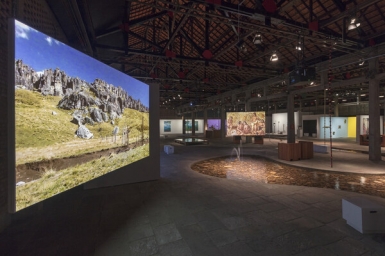Created in 1983 by Solange Farkas, Videobrasil has consolidated itself over the years as a diversified and multiple platform aimed at fostering, reflecting and disseminating the artistic production of the Global South. Initially entitled Videobrasil Festival, and casting an inquisitive gaze still in the last years of the civil-military dictatorship that devastated Brazil (1964–1985), the event focused on the innovative video production that was becoming popular across the country.
After a few annual editions, Videobrasil consolidated itself in the national art schedule and began to be held every two years as of the early 1990s, while also establishing a fruitful and lasting partnership with Sesc-SP. It was also during this period that Farkas created the Associação Cultural Videobrasil, dedicated to maintaining and activating the growing collection that grew at each event, and established a more specific focus on the production of the so-called Global South—a term that refers to territories on the margins of central capitalism, located mainly in Latin America, Africa, Eastern Europe, Asia and the Middle East.
Another important moment in the history of the Biennial Sesc_Videobrasil—which is now in its 22nd edition, under the title “Memory is an Editing Station”—was the inclusion, in its shows, starting in 2011, of the widest possible range of artistic forms and media in addition to video and electronic art. It is also worth noting, especially in its latest editions, a growing focus on the production of indigenous populations from Brazil and from the most distant corners of the globe.
Selection via Open Call
The selection of artists, via open call and carried out by a committee of guest curators, is a democratic and vital strategy for the Biennial. The Open Call allows for the construction of a space aimed at visibility, dialogue and knowledge production surrounding the art produced in the relevant countries.
Videobrasil Historical Collection
The selected artists with video pieces will have their works included in the Videobrasil Historical Collection, which is comprised of the videos selected in all editions of the Biennial. Part of the Association's archive, the Historical Collection is the object of the institution's preservation and safeguard policy, which also ensures the promotion and dissemination of works through permanent activation initiatives.
Prizes
At each edition, the Biennial grants cash prizes and eight-week artist residency awards at institutions worldwide that are partners of the Videobrasil Residency Program. The winning artists are nominated by juries comprised of leading names on the international scene.
Winning artists or collectives will also receive the Southern Panoramas Trophy, created by a nationally renowned artist. Some of the artists that have collaborated in previous editions include Tunga, Luiz Zerbini, Rosângela Rennó, Erika Verzutti, Carmela Gross, Flávia Ribeiro, Efrain Almeida and Alexandre da Cunha.
Dissemination and reflection
The artists selected for the Biennials have their works disseminated on digital research platforms, websites, on the social media pages of the Associação Cultural Videobrasil, as well as in documentaries and videos made for social media and produced by the organization. The Biennial also hosts public programs that include debates, courses, workshops and publication launches that gather artists, curators, critics, researchers, representatives of institutions and artistic residencies around the reflection and discussion of urgent topics related to art and culture.
The bilingual publications produced by the Biennial include reflexive and critical texts, image records of the works and the creative process of the selected artists, expanding the institution's efforts beyond the event itself and, above all, boosting its international circulation. More than a mere record of the event, these publications are an important part of the curatorial project, and essential for it to reach its goals of dissemination and reflection around the themes proposed at each edition.
Thus, Videobrasil and Sesc-SP seek to intensify and expand the collaboration between artists, peoples and cultures, fostering dialogue and establishing horizontal debates that express the movement of ideas and practices in the contemporary world. “It has always been a militancy on our part to try to create bridges and networks that allow transit among us, of the Global South, so that it can exist without artists always having to be sanctioned by the North,” claims Farkas.
Aware that the concept of the Global South is not a solid one, and refers to a geopolitical territory in constant transformation, the Biennial also took on the important role of promoting dialogue between the artistic production of the South and the work of well-established artists from different regions of the world, and has showcased works by Olafur Eliasson (Denmark); Bill Viola, Gary Hill and Coco Fusco (USA); Peter Greenaway (United Kingdom); Marcel Odenbach (Germany); Akram Zaatari (Lebanon); Fabrizio Plessi (Italy); Robert Cahen (France); Eder Santos, Chelpa Ferro, Waly Salomão (Brazil), among others.







